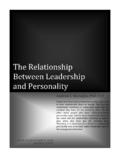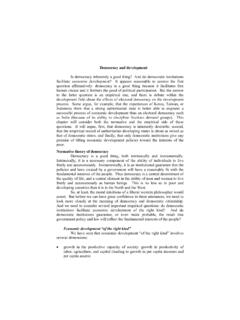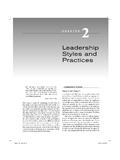Transcription of Leadership Styles - ed
1 Harnessing the Power of Adventure Leadership Styles By Carlin Val and Jess Kemp The intent of this study was to examine offered researchers the highest diversity in how a group's dynamic changes under the data when comparing Leadership Styles to influence of different Leadership Styles , and group dynamic. The voyageur canoe field to determine what Leadership style works explorations course contained the following best in a large group expedition. The main themes: question identified was What roles can a leader play in affecting the dynamic of 1.
2 Leader of the day: experiencing different a large group while partaking in a field kinds of Leadership each day. expedition? 2. Voyageur Heritage Interpretation: learning about the day-to-day lifestyles The following research questions were of the voyageurs. addressed: 3. Land Heritage Interpretation: learning about the history of the trip's route. 1. How can a leader create a positive group 4. Teaching Heritage Interpretation: dynamic while facilitating an outdoor teaching children in the surrounding experience? communities while on the canoe trip.
3 2. How does Leadership affect group dynamics? Leadership Styles 3. How does Leadership and decision- making interconnect within a positive Leadership is the ability to move a group group dynamic? towards a common goal that would not be 4. Which Leadership style works best for met if a leader had not been there (Graham, various situations in the field? 1997). Researchers of this study categorized 5. What are the barriers and pathways for Leadership Styles into three main Styles of each Leadership style? Leadership , which helped to organize the observations into more simplified data.
4 Data was collected to draw a connection between Leadership Styles and their affects Autocratic ( authoritarian ) Leadership on the group dynamics of large groups during outdoor expeditions. When faced with the need to provide a decision, an autocratic leader is one who The Research Context would come up with a solution for the entire group on their own. The autocratic leader Field Explorations I is a third-year course would generally solve an issue and make that is offered as a mandatory credit to decisions for the group using observations Outdoor Recreation students at Lakehead and what they feel is needed or most University.
5 Students of the 2007 class had important for the majority of the group the option to choose from three different members to benefit at that time (Dessler &. field trips: crown of the continents (hiking), Starke, 2004). While recording the research, dogsledding, or a voyageur canoe trip. these were the leaders that would decide for These courses help to teach theoretical the group when they would wake up and and applied topics that relate to outdoor depart, and exactly how far they should go Leadership , parks and tourism. The for that day. If the group came across any PATHWAYS.
6 Voyageur canoe trip was the only course conflicts or barriers within the expedition, that was free to take. As a result, a high these leaders would also make the decisions number of students enrolled on this trip. on their own, inquiring feedback from the It was because of this high number that three hired instructors to ensure that their researchers chose this expedition to conduct decisions were okay. 28 research. The high enrollment of students Harnessing the Power of Adventure Democratic (participative) Leadership questions. The approach taken to this research was the Grounded theory , in which The democratic leaders were those who a concept is exposed through continuous took a very relaxed yet in-control approach data collection and assessment (Glaser &.)
7 To leading the group. Participative leaders, Strauss, 1967). The research began with a more often than not, would consult the look at generative questions that helped to group when approaching an issue and guide the research, but were neither static consider their suggestions, but the leader nor restricting (Glaser & Strauss, 1967). retains the final say in what particular Most of the research was gathered while approach is taken (Dessler & Starke, 2004). participating in the field of the expedition. Within the expedition setting, many of The research was gathered in three different the participants displayed this kind of methods: a self-diagnosis of individuals'.
8 Leadership by obtaining suggestions from own Leadership Styles , daily field notes by other members of the group to come to a the researchers and finally, a focus group group consensus when trying to solve a held at the end of the trip. Answers to the problem or an issue. These leaders would main questions were developed and from then talk amongst themselves and come to a those answers, common themes as well as decision as to what the group would do. theories resulted. Laissez-faire (abdicratic) Leadership Conflicts The laissez-fair approach to Leadership is Before the voyageur expedition took place, the idea that the participants should be able researchers had created a list of possible to work problems out and make their way conflicts that would arise.
9 Conflicts were through an expedition without too much considered prior to the voyageur expedition extra guidance. These kinds of leaders would as a method to foresee skews in data provide very little guidance when dealing collection. with group issues on the expedition and would allow group members to come up Assumed conflicts with decisions on their own. The abdicratic leader would take an extremely hands-off The following is a list of possible conflicts: approach to leading in order to encourage group problem-solving and critical thinking, Weather (wind days, rain, cold).
10 Without allowing participants to depend Portages on the leader for the final word (Dessler & Equipment malfunction Starke, 2004). This approach was seen when Students' level of comfort suggestions would be made to the leader to Distance covered take a certain approach and the leader would Personality conflicts just respond with a simple sure, let's do it, . and decisions were made without a lot of Actual conflicts consideration. After the voyageur expedition, the It is important to note that in the real world researchers found the following to be actual it is highly improbable to have a completely conflicts that had the ability to alter data democratic or completely autocratic leader collection: (Martin, Cashel, Wagstaff, & Breunig, in press).
















